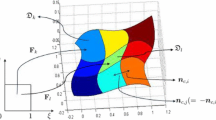Abstract
Partial differential equations (PDEs) combined with suitably chosen boundary conditions are effective in creating free form surfaces. In this paper, a fourth order partial differential equation and boundary conditions up to tangential continuity are introduced. The general solution is divided into a closed form solution and a non-closed form one leading to a mixed solution to the PDE. The obtained solution is applied to a number of surface modelling examples including glass shape design, vase surface creation and arbitrary surface representation.
Similar content being viewed by others
References
Farin G. Curves and Surfaces for Computer Aided Geometric Design: A Practical Guide. 4th Edition, Academic Press, 1997.
Terzopoulos D, Fleischer K. Deformable models.The Visual Computer, 1988, 4: 306–331.
Terzopoulos D, Fleischer K. Modeling inelastic deformations: Viscoelasticity, plasticity, fracture.Computer Graphics, 1988, 22(4): 269–278.
Celniker G, Gossard D. Deformable curve and surface finite-elements for free-form shape design.Computer Graphics, 1991, 25(4): 257–266.
Kang H, Kak A. Deforming virtual objects interactively in accordance with an elastic model.Computer-Aided Design, 1996, 28(4): 251–262.
Güdükbay U, Özgüç B. Animation of deformable models.Computer-Aided Design, 1994, 26(12): 868–875.
Qin H, Terzopoulos D. Triangular NURBS and their dynamic generations.Computer Aided Geometric Design, 1997, 14: 325–347.
Guan Z, Lin J, Tao N, Ping X, Tang R. Study and application of physics-based deformable curves and surfaces.Computers and Graphics, 1997, 21(3): 305–313.
Bloor M I G, Wilson M J. Using partial differential equations to generate free-form surfaces.Computer-Aided Design, 1990, 22(4): 202–212.
Bloor M I G, Wilson M J. Spectral approximations to PDE surfaces.Computer-Aided Design, 1996, 28(2): 145–152.
Bloor M I G, Wilson M J. Representing PDE surfaces in terms of B-splines.Computer Aided Design, 1990, 22(6): 324–331.
Cheng S Y, Bloor M I G, Saia A, Wilson M J. Blending between quadric surfaces using partial differential equations. InAdvances in Design Automation, Ravani B (ed.). Vol. 1,Computer Aided and Computational Design, ASME, 1990, pp.257–264.
Brown J M, Bloor M I G, Susan M, Wilson M J. Generation and modification of non-uniform B-spline surface approximations to PDE surfaces using the finite element method. InAdvances in Design Automation, Ravani B (ed.), Vol. 1,Computer Aided and Computational Design, ASME 1990, pp.265–272.
Li Z C. Boundary penalty finite element methods for blending surfaces. 1. Basic theory.Journal of Computational Mathematics, 1998, 16: 457–480.
Li Z C. Boundary penalty finite element methods for blending surfaces, II. Biharmonic equations.Journal of Computational and Applied Mathematics, 1999, 110: 155–176.
Li Z C, Chang C-S. Boundary penalty finite element methods for blending surfaces, III. Superconvergence and stability and examples.Journal of Computational and Applied Mathematics, 1999, 110: 241–270.
Ugail H, Bloor M I G, Wilson M J. Techniques for interactive design using the PDE method.ACM Trans. Graphics, 1999, 18(2): 195–212.
Ugail H, Bloor M I G, Wilson M J. Manipulation of PDE surfaces using an interactively defined parameterisation.Computers & Graphics, 1999, 23: 525–534.
Zhang J J, You L H. Surface representation using second, fourth and mixed order partial differential equations.International Conference on Shape Modelling and Applications, Genova, Italy, May 7–11, 2001, pp.250–256.
Zhang J J, You L H. PDE based surface representation.Computers & Graphics, 2002, 26(1): 89–98.
Author information
Authors and Affiliations
Corresponding author
Additional information
Jian-Jun Zhang is a professor of computer graphics at the National Centre for Computer Animation, Bournemouth Media School, Bournemouth University, UK. His research interests include computer graphics, computer animation, geometric modelling, physics-based simulation and medical visualisation. Currently he is the head of research at Bournemoth Media School.
Li-Hua You is currently a research fellow at the National Centre for Computer Animation, Bournemouth Media School, Bournemouth University, UK. His research interests are computer graphics, computer animation and geometric modelling.
Rights and permissions
About this article
Cite this article
Zhang, JJ., You, LH. PDE surface generation with combined closed and non-closed form solutions. J. Comput. Sci. & Technol. 19, 650–656 (2004). https://doi.org/10.1007/BF02945591
Received:
Issue Date:
DOI: https://doi.org/10.1007/BF02945591




